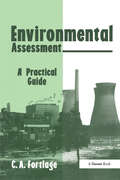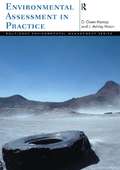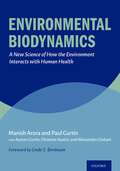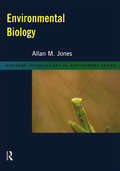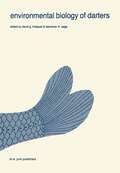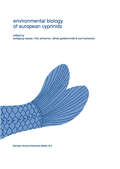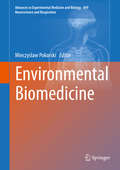- Table View
- List View
Environmental Assessment: A Practical Guide
by C.A. FortlageEnvironmental assessment is a means of counteracting, foreseeing and controlling interference in the environment. All new major developments in Europe and North America are now subjects of scrutiny to prevent them from causing significant harmful effects to the land, sea or air. This book is an essential guide to the process, reviewing the history and background to assessment, summarizing the current legislation and providing useful advice on the skills and management techniques needed for a successful environmental assessment project. Environmental Assessment opens with a review of the US origins of the scheme, definitions and explanations of how the UK has implemented controls. This is followed by the law, rules, regulations and legislation applicable to the UK and the EC directives for the European Community. The author examines management and monitoring, setting up project teams, researching and presenting effective information, as well as calculating and analysing the potential effects of the project. Mitigating measures and alternatives are discussed, as are qualitative assessment techniques. The book has been written for architects, planners and landscape designers, who may be unfamiliar with the techniques, but who are directly involved in shaping the landscape. It would also be a valuable handbook for local planning authority councillors, environmental groups and anyone involved in sensitive development proposals. Although not written as a textbook, environmental students will discover clear jargon-free explanations of and insights into the practice of environmental assessment.
Environmental Assessment: A Practical Guide
by C.A. FortlageEnvironmental assessment is a means of counteracting, foreseeing and controlling interference in the environment. All new major developments in Europe and North America are now subjects of scrutiny to prevent them from causing significant harmful effects to the land, sea or air. This book is an essential guide to the process, reviewing the history and background to assessment, summarizing the current legislation and providing useful advice on the skills and management techniques needed for a successful environmental assessment project. Environmental Assessment opens with a review of the US origins of the scheme, definitions and explanations of how the UK has implemented controls. This is followed by the law, rules, regulations and legislation applicable to the UK and the EC directives for the European Community. The author examines management and monitoring, setting up project teams, researching and presenting effective information, as well as calculating and analysing the potential effects of the project. Mitigating measures and alternatives are discussed, as are qualitative assessment techniques. The book has been written for architects, planners and landscape designers, who may be unfamiliar with the techniques, but who are directly involved in shaping the landscape. It would also be a valuable handbook for local planning authority councillors, environmental groups and anyone involved in sensitive development proposals. Although not written as a textbook, environmental students will discover clear jargon-free explanations of and insights into the practice of environmental assessment.
Environmental Assessment and Habitat Evaluation of the Upper Great Lakes Connecting Channels (Developments in Hydrobiology #65)
by M. Munawar T. EdsallEnvironmental Assessment in Practice (Routledge Environmental Management)
by Owen Harrop Ashley NixonThis text explains what constitutes good practice in applying environmental assessment as an environmental management tool. A wide range of case studies and other student text features are employed to demonstrate how the different methods, techniques and disciplines of environmental assessment can be used. The authors address the key concepts for environmental assessment procedures: methods for using E.A.; techniques for impact prediction and evaluation; environmental risk assessment; EA consultation and participation; project management; environmental statement review and post-project analysis; and strategic environmental assessment.Worldwide case studies include: gas pipelines, hydroelectric power plants, gold mining, river crossings, waste-to-energy plants and gravel extraction in England, Scotland, Ireland, Canada, the USA, Venezuela, the Netherlands, Iceland, Zambia, Zimbabwe, South Africa and Ghana.
Environmental Assessment in Practice (Routledge Environmental Management)
by Owen Harrop Ashley NixonThis text explains what constitutes good practice in applying environmental assessment as an environmental management tool. A wide range of case studies and other student text features are employed to demonstrate how the different methods, techniques and disciplines of environmental assessment can be used. The authors address the key concepts for environmental assessment procedures: methods for using E.A.; techniques for impact prediction and evaluation; environmental risk assessment; EA consultation and participation; project management; environmental statement review and post-project analysis; and strategic environmental assessment.Worldwide case studies include: gas pipelines, hydroelectric power plants, gold mining, river crossings, waste-to-energy plants and gravel extraction in England, Scotland, Ireland, Canada, the USA, Venezuela, the Netherlands, Iceland, Zambia, Zimbabwe, South Africa and Ghana.
Environmental Assessment of Lightweight Electric Vehicles (Sustainable Production, Life Cycle Engineering and Management)
by Patricia EgedeThis monograph adresses the challenge of the environmental assessment of leightweight electric vehicles. It poses the question whether the use of lightweight materials in electric vehicles can reduce the vehicles’ environmental impact and compares the environmental performance of a lightweight electric vehicle (LEV) to other types of vehicles. The topical approach focuses on methods from life cycle assessment (LCA), and the book concludes with a comprehensive concept on the environmental assessment of LEVs. The target audience primarily comprises LCA practitioners from research institutes and industry, but it may also be beneficial for graduate students specializing in the field of environmental assessment.
Environmental Assessment of Patagonia's Water Resources (Environmental Earth Sciences)
by Américo Iadran Torres Verena Agustina CampodonicoThis book presents contributions devoted to the hydrogeochemical characterization of aquatic environments of Patagonia, including those of Ushuaia city, known as "The southernmost city in the world". Patagonia (between 39° and 55° S) is located in southern South America. Eight main river systems pour their waters into the SW Atlantic Ocean. Rivers, with their headwaters mainly located in the Andes, supply dissolved and particulate matter to the coastal zone, as well as nutrients, which benefit biological communities. Besides, freshwater in this region with little anthropogenic impact supports human life and a high wildlife biodiversity. Unfortunately, the recent increase in human activities, such as the use of fertilizers, wastewater discharges, extensive deforestation and dam construction, is affecting the quality and quantity of water resources. The book is of interest for researchers, professors and government agencies that decide on water resources management policies.
Environmental Assessment of Recycled Waste (Environmental Footprints and Eco-design of Products and Processes)
by Subramanian Senthilkannan MuthuThis book with its six interesting chapters highlights the environmental assessment of recycled waste. Waste Management is one of the main topics of concern for an organization and a nation. Out of different destinations at the end of life for a product, Recycling is the need of the hour and is an inevitable destination. Literally all wastes (be it- postindustrial or post-consumer states) if they cannot be reused, have to be recycled. Recycled products are in demand today and we are seeing many recycled alternatives for almost all industrial sectors. One of the million-dollar question to answer in terms of recycling and recycled products is- whether the recycled products are environmentally sustainable than the virgin alternatives? It is highly imperative to ascertain the environmental footprints of recycled products and recycling processes and also find out the best possible ways to further improve the environmental benefits of such recycled products and recycling processes.
Environmental Bioassay Techniques and their Application: Proceedings of the 1st International Conference held in Lancaster, England, 11–14 July 1988 (Developments in Hydrobiology #54)
by M. Munawar G. Dixon C. I. Mayfield Trefor B. Reynoldson M. H. SadarProceedings of the First International Conference held in Lancaster, England, July 11-14, 1988
Environmental Biodynamics: A New Science of How the Environment Interacts with Human Health
by Manish Arora Paul CurtinIs there a central scientific theory governing how human physiology interacts with the environment? Our environment exerts a profound effect on our health and well-being. Yet, the rules guiding such interaction between individual human physiology and the environment remain elusive. While various disciplines have emerged studying components and base interactions of each system, no method has successfully predicted the dynamic behavior between these complex systems in real time. Environmental Biodynamics offers a daring new inquiry into our environment and its impact on human health. Moving beyond a reductionist view of human physiology and the environment, this volume proposes a fundamental shift in environmental health science from quantifying structural relationships, such as static measures of environmental factors or momentary health indicators, to studying functional interdependencies in time. Across six chapters, the authors weave together the latest research from biology, environmental science, theoretical physics, mathematics, and philosophy to explore their Biodynamic Interface Theory, which states that complex systems connect primarily through a dynamic, operationally independent interface that regulates the bidirectional interactions between systems over time. Later chapters compare the proposed theory against current practice and provide suggestions for further methods of data collection and computational analysis. Supported by vivid full-color diagrams and a wealth of original data, Environmental Biodynamics is an accessible theoretical guide to this promising new field of environmental health
Environmental Biodynamics: A New Science of How the Environment Interacts with Human Health
by Manish Arora Paul CurtinIs there a central scientific theory governing how human physiology interacts with the environment? Our environment exerts a profound effect on our health and well-being. Yet, the rules guiding such interaction between individual human physiology and the environment remain elusive. While various disciplines have emerged studying components and base interactions of each system, no method has successfully predicted the dynamic behavior between these complex systems in real time. Environmental Biodynamics offers a daring new inquiry into our environment and its impact on human health. Moving beyond a reductionist view of human physiology and the environment, this volume proposes a fundamental shift in environmental health science from quantifying structural relationships, such as static measures of environmental factors or momentary health indicators, to studying functional interdependencies in time. Across six chapters, the authors weave together the latest research from biology, environmental science, theoretical physics, mathematics, and philosophy to explore their Biodynamic Interface Theory, which states that complex systems connect primarily through a dynamic, operationally independent interface that regulates the bidirectional interactions between systems over time. Later chapters compare the proposed theory against current practice and provide suggestions for further methods of data collection and computational analysis. Supported by vivid full-color diagrams and a wealth of original data, Environmental Biodynamics is an accessible theoretical guide to this promising new field of environmental health
Environmental Bioengineering: Volume 11 (Handbook of Environmental Engineering #11)
by Lawrence K. K. Wang Joo-Hwa Tay Stephen Tiong Lee Tiong-Lee Tay Yung-Tse HungThe past 30 years have seen the emergence of a growing desire worldwide that positive actions be taken to restore and protect the environment from the degrading effects of all forms of pollution – air, water, soil, and noise. Since pollution is a direct or indirect consequence of waste production, the seemingly idealistic demand for “zero discharge” can be construed as an unrealistic demand for zero waste. However, as long as waste continues to exist, we can only attempt to abate the subsequent pollution by converting it to a less noxious form. Three major questions usually arise when a particular type of pollution has been identi ed: (1) How serious is the pollution? (2) Is the technology to abate it available? and (3) Do the costs of abatement justify the degree of abatement achieved? This book is one of the volumes of the Handbook of Environmental Engineering series. The principal intention of this series is to help readers formulate answers to the above three questions. The traditional approach of applying tried-and-true solutions to speci c pollution problems has been a major contributing factor to the success of environmental engineering, and has accounted in large measure for the establishment of a “methodology of pollution control. ” However, the realization of the ever-increasing complexity and interrelated nature of current environmental problems renders it imperative that intelligent planning of pollution abatement systems be undertaken.
Environmental Biology
by Allan M. JonesEnvironmental Biology offers an accessible introduction to the core elements of biology and the biosphere. With balanced coverage of acquatic and terrestrial examples throughout, the text builds logically to present a clear understanding of the fundamental processes of life before examining its more complex components, namely individuals, populations, communities and ecosystems.A knowledge of environmental biology and its practical applications is essential for a deeper understanding of the environment. Environmental Biology offers an invaluable introduction to the living environment for all areas of study, from environmental history, agriculture and forestry, to impact assessment, climate change, ecology and conservation.
Environmental Biology (Routledge Introductions to Environment: Environmental Science)
by Allan M. JonesEnvironmental Biology offers an accessible introduction to the core elements of biology and the biosphere. With balanced coverage of acquatic and terrestrial examples throughout, the text builds logically to present a clear understanding of the fundamental processes of life before examining its more complex components, namely individuals, populations, communities and ecosystems.A knowledge of environmental biology and its practical applications is essential for a deeper understanding of the environment. Environmental Biology offers an invaluable introduction to the living environment for all areas of study, from environmental history, agriculture and forestry, to impact assessment, climate change, ecology and conservation.
Environmental Biology for Engineers and Scientists
by David A. Vaccari Peter F. Strom James E. AllemanThe growth of the environmental sciences has greatly expanded the scope of biological disciplines today's engineers have to deal with. Yet, despite its fundamental importance, the full breadth of biology has been given short shrift in most environmental engineering and science courses. Filling this gap in the professional literature, Environmental Biology for Engineers and Scientists introduces students of chemistry, physics, geology, and environmental engineering to a broad range of biological concepts they may not otherwise be exposed to in their training. Based on a graduate-level course designed to teach engineers to be literate in biological concepts and terminology, the text covers a wide range of biology without making it tedious for non-biology majors. Teaching aids include: * Notes, problems, and solutions * Problem sets at the end of each chapter * PowerPoints(r) of many figures A valuable addition to any civil engineering and environmental studies curriculum, this book also serves as an important professional reference for practicing environmental professionals who need to understand the biological impacts of pollution.
Environmental biology of darters: Papers from a symposium on the comparative behavior, ecology, and life histories of darters (Etheostomatini), held during the 62nd annual meeting of the American Society of Ichthyologists and Herpetologists at DeKalb, Illinois, U.S.A., June 14–15, 1982 (Developments in Environmental Biology of Fishes #4)
by David G. Lindquist Lawrence M. PageThe The following following set set of of papers papers is is mainly mainly a a representa representa have have been been overdue overdue since since the the pioneering pioneering work work of of tive tive sample sample from from 19 19 presentations presentations at at a a special special sym sym Howard Howard Winn Winn in in the the late late 1950's. 1950's. Darters Darters are are rela rela posium posium on on the the comparative comparative behavior, behavior, ecology, ecology, and and tively tively sedentary sedentary and and can can be be easily easily observed observed and and life life histories histories of of darters darters held held during during the the 62nd 62nd (14-15 (14-15 experimentally experimentally manipulated manipulated in in their their natural natural hab- . . June, June, 1982) 1982) annual annual meeting meeting of of the the American American So So itats. itats. They They can can be be transported transported alive alive with with relative relative ciety ciety of of Ichthyologists Ichthyologists and and Herpetologists Herpetologists on on the the ease, ease, and and readily readily acclimate acclimate to to controlled controlled conditions conditions campus campus of of Northern Northern Illinois Illinois University, University, DeKalb, DeKalb, of of the the laboratory laboratory aquarium. aquarium. The The male male nuptial nuptial color color Illinois, Illinois, U. S. A. U. S. A.
Environmental biology of European cyprinids: Papers from the workshop on ‘The Environmental Biology of Cyprinids’ held at the University of Salzburg, Austria, in September 1989 (Developments in Environmental Biology of Fishes #13)
by W. Wieser F. Schiemer A. Goldschmidt K. KotrschalEnvironmental Biomedicine (Advances in Experimental Medicine and Biology #849)
by Mieczyslaw PokorskiThe book presents the latest advances in research into health effects of air pollution, with heavy motor vehicle traffic or cigarette smoke as the exemplar of pollution. The airways are the first-line defense system against pollution. The book focuses on respiratory ailments underlain by inflammation, increased susceptibility to infection, particularly acquired during harsh environmental conditions and exposures to particulate matter or pathogens. The importance of astute analysis of lung function for early diagnosis of disorders is underscored. A knowledge deficit concerning the aerosolized drug delivery through the airways also is addressed. Recent developments and viewpoints in the field of environmental health hazards as well as methodological advances in their assessment are provided. The book will be of interest to pulmonologists, healthcare providers, researchers and clinicians engaged in environment-related respiratory diseases, but also to policy makers concerned with clean ambient air quality.
Environmental Bioremediation Technologies
by S. N. Singh R. D. TripathiBioremediation is an eco-friendly, cost-effective and natural technology targeted to remove heavy metals, radionuclides, xenobiotic compounds, organic waste, pesticides etc. from contaminated sites or industrial discharges through biological means. Since this technology is used in in-situ conditions, it does not physically disturb the site unlike conventional methods i.e. chemical or mechanical methods.
Environmental Biotechnology: Sustainable Remediation of Contamination in Different Environs
by Rouf Ahmad BhatThis book provides a review of innovative and novel biotechnological techniques that can be implemented to assess, analyze, and mitigate harmful pollutants and wastes that result from agricultural and industrial operations. It helps to meet the much-needed demand for improvement of low-cost technologies that tackle pollution problems scientifically for the safeguard of the environment, focusing on bioremediation solutions that also create useful and renewable forms of energy. The biotechnological interventions discussed in the volume include approaches involving genomics, proteomics, transcriptomics, metabolomics, and fluxomics. In addition, biological agents such as microalgae, bacteria, fungi, and bacteriophage, which can also prove to be helpful in the elimination of wastes, are explored. Topics in Environmental Biotechnology: Sustainable Remediation of Contamination in Different Environs include the associated consequences and hazards from agricultural and industrial waste and a variety of bioremediation measures, including the use of bioaugmentation, biosensors, challenges of biofuel production, and more. The book is directed to researchers, scientists, industrialists, farmers, agricultural waste management authorities, as well as to faculty and students, and aims to help implement these novel technologies for environmental stability.
Environmental Biotechnology: Sustainable Remediation of Contamination in Different Environs
by Rouf Ahmad Bhat Moonisa Aslam Dervash Khalid Rehman Hakeem Khalid Zaffar MasoodiThis book provides a review of innovative and novel biotechnological techniques that can be implemented to assess, analyze, and mitigate harmful pollutants and wastes that result from agricultural and industrial operations. It helps to meet the much-needed demand for improvement of low-cost technologies that tackle pollution problems scientifically for the safeguard of the environment, focusing on bioremediation solutions that also create useful and renewable forms of energy. The biotechnological interventions discussed in the volume include approaches involving genomics, proteomics, transcriptomics, metabolomics, and fluxomics. In addition, biological agents such as microalgae, bacteria, fungi, and bacteriophage, which can also prove to be helpful in the elimination of wastes, are explored. Topics in Environmental Biotechnology: Sustainable Remediation of Contamination in Different Environs include the associated consequences and hazards from agricultural and industrial waste and a variety of bioremediation measures, including the use of bioaugmentation, biosensors, challenges of biofuel production, and more. The book is directed to researchers, scientists, industrialists, farmers, agricultural waste management authorities, as well as to faculty and students, and aims to help implement these novel technologies for environmental stability.
Environmental Biotechnology: Theory and Application
by Gareth G. Evans Judy FurlongEnvironmental Biotechnology: Theory and Applications, 2nd Edition is designed to draw together the microscopic, functional level and the macroscopic, practical applications of biotechnology and to explain how the two relate within an environmental context. It presents the practical biological approaches currently employed to address environmental problems and provides the reader with a working knowledge of the science that underpins them. Biotechnology has now become a realistic alternative to many established approaches for manufacturing, land remediation, pollution control and waste management and is therefore an essential aspect of environmental studies. Fully updated to reflect new developments in the field and with numerous new case studies throughout this edition will be essential reading for undergraduates and masters students taking modules in Biotechnology or Pollution Control as part of Environmental Science, Environmental Management or Environmental Biology programmes. Quote from the first edition: "There is no doubt that this book will be one of inspiration for all professionals in the field. It is a very good framework for understanding the complex nature of processes and technology and as such it will be useful for researchers, practitioners and other parties who need a working knowledge of this fascinating subject." —Professor Bjorn Jensen, Chairman of the European Federation of Biotechnology, Environmental Biotechnology section and Research and Innovation Director, DHI Water and Environment
Environmental Biotechnology: Theory and Application
by Gareth G. Evans Judy FurlongEnvironmental Biotechnology: Theory and Applications, 2nd Edition is designed to draw together the microscopic, functional level and the macroscopic, practical applications of biotechnology and to explain how the two relate within an environmental context. It presents the practical biological approaches currently employed to address environmental problems and provides the reader with a working knowledge of the science that underpins them. Biotechnology has now become a realistic alternative to many established approaches for manufacturing, land remediation, pollution control and waste management and is therefore an essential aspect of environmental studies. Fully updated to reflect new developments in the field and with numerous new case studies throughout this edition will be essential reading for undergraduates and masters students taking modules in Biotechnology or Pollution Control as part of Environmental Science, Environmental Management or Environmental Biology programmes. Quote from the first edition: "There is no doubt that this book will be one of inspiration for all professionals in the field. It is a very good framework for understanding the complex nature of processes and technology and as such it will be useful for researchers, practitioners and other parties who need a working knowledge of this fascinating subject." —Professor Bjorn Jensen, Chairman of the European Federation of Biotechnology, Environmental Biotechnology section and Research and Innovation Director, DHI Water and Environment
Environmental Biotechnology
by M. H. FulekarThis book provides information essential to students taking courses in biotechnology as part of environmental sciences, environmental management, or environmental biology programs. It is also suitable for those studying water, waste management, and pollution abatement. Topics include biodiversity, renewable energy, bioremediation technology, recomb
Environmental Biotechnology: Fundamentals to Modern Techniques (Emerging Materials and Technologies)
by Sibi GThis book approaches the topic of environmental biotechnology in a clear, integrated, and meaningful way, covering both the fundamentals and biochemical processes involved, as well as the technologies themselves within different areas of application. As part of the framework, it also provides a thorough description of the pollution and its control, and the role of microorganisms in a wide range of ecosystems and deterioration processes. Features: Focuses on the role of microorganisms in a wide range of ecosystems and deterioration processes. Explains underlying concepts of environment, interlinks them from an ecological point of view, and describes the approaches for waste treatment. Describes the concepts and fate processes of environmental contaminants, contaminant patterns in soil, groundwater, and surface water. Includes novel research findings and applications of biosurfactants. Discusses biodegradation as a key process in the bioremediation of recalcitrant compounds. This book is aimed at Primarily Senior Undergraduates including Graduate Students and Researchers in Biotechnology, Environmental Science/Engineering, Conservation Biology, Microbiology, Waste Management, and Ecology.
